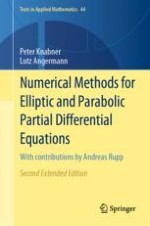This graduate-level text provides an application oriented introduction to the numerical methods for elliptic and parabolic partial differential equations. It covers finite difference, finite element, and finite volume methods, interweaving theory and applications throughout. The book examines modern topics such as adaptive methods, multilevel methods, and methods for convection-dominated problems and includes detailed illustrations and extensive exercises. For students with mathematics major it is an excellent introduction to the theory and methods, guiding them in the selection of methods and helping them to understand and pursue finite element programming. For engineering and physics students it provides a general framework for the formulation and analysis of methods. This second edition sees additional chapters on mixed discretization and on generalizing and unifying known approaches; broader applications on systems of diffusion, convection and reaction; enhanced chapters on node-centered finite volume methods and methods of convection-dominated problems, specifically treating the now-popular cell-centered finite volume method; and the consideration of realistic formulations beyond the Poisson's equation for all models and methods.
